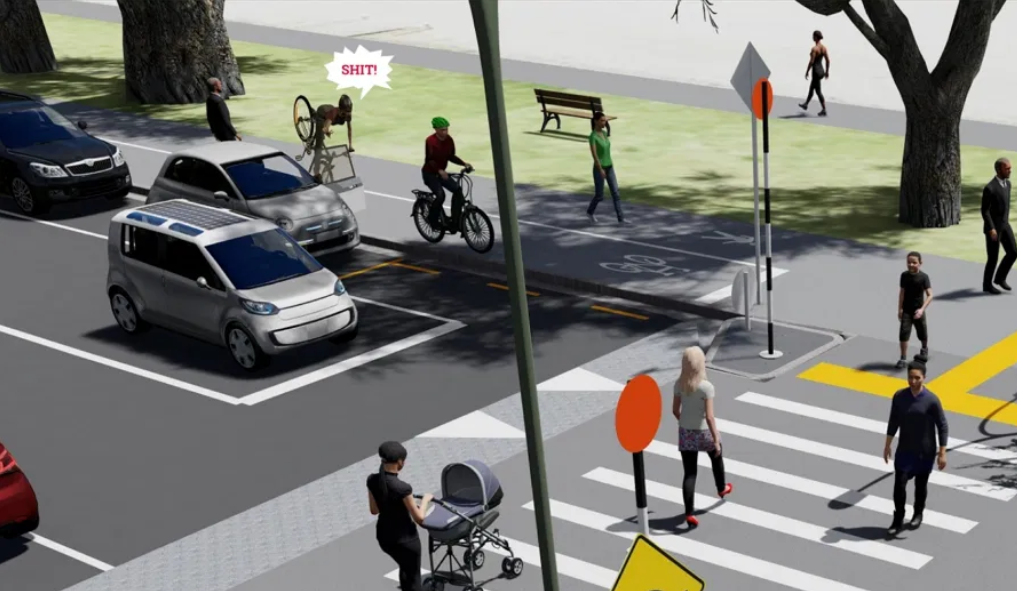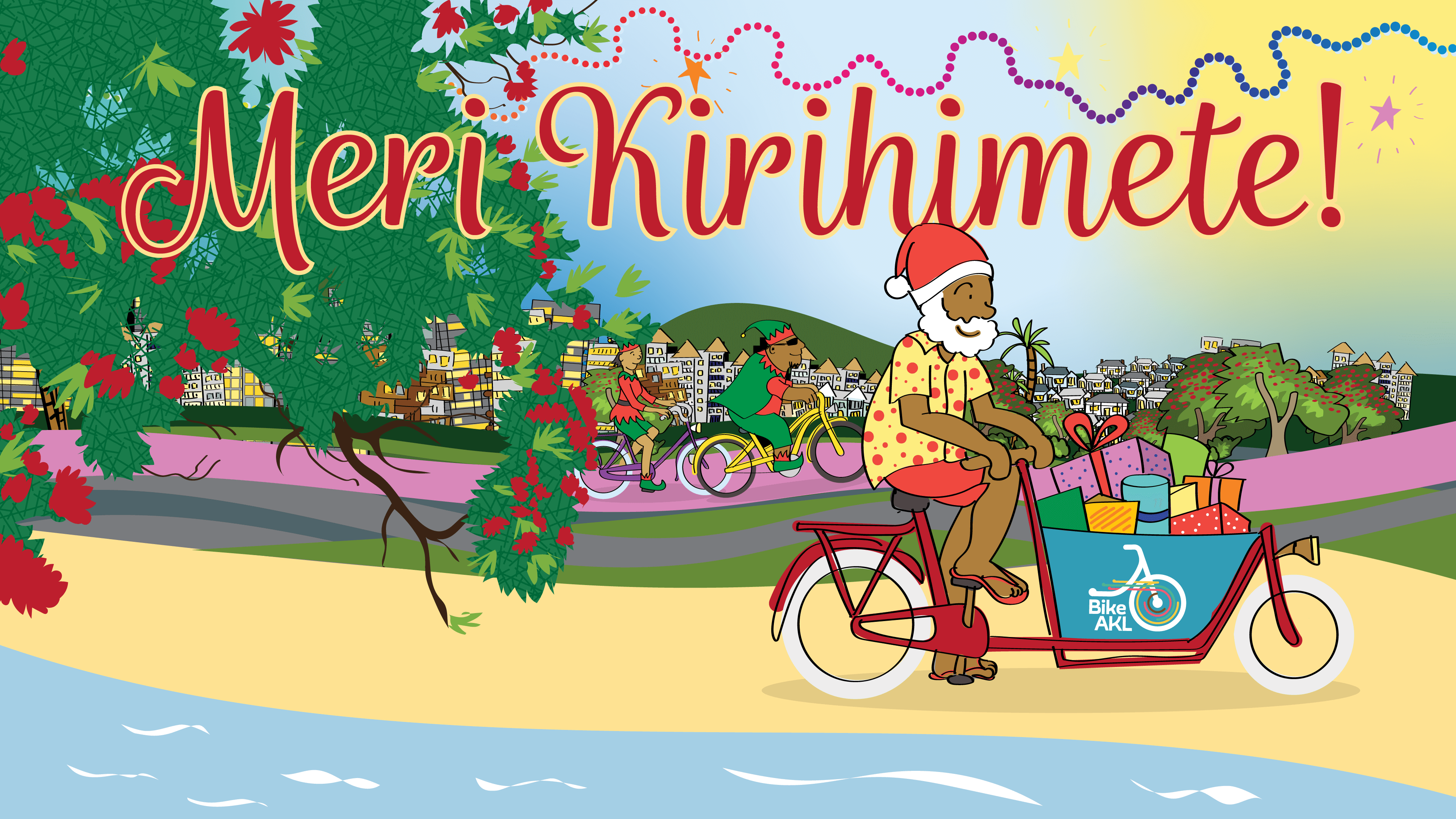FEEDBACK CLOSES MONDAY 2 NOVEMBER
After an initial go in 2019, Auckland Transport’s latest safety improvement plans for St Heliers village are out for consultation – but they haven’t improved much, with safe walking and biking again pushed aside in the name of… well, parking.
This isn’t good enough in a Vision Zero world, and we’re sending the strong message that we don’t support the project as it currently stands. To make that message clear to AT, we need your help!
If you agree AT needs to do better, please raise your voice before 2 November.
Check out the official project page
Read on for our submission suggestions and detailed analysis of the issues
Ideas for your feedback
Bike Auckland encourages those submitting on this project to tell AT that you either
- don’t support this project (and say why), or
- support with changes – and add clear statements of what those changes should be (BUT note that if you tick this option, you will likely end up being counted as “in favour”, at least in the headline results of AT’s consultation summary – even if they change nothing about the plans…)
We can’t support the project in its current form because it doesn’t include adequate safe provision for pedestrians or cyclists, and is inconsistent with AT’s Transport Design Manual and the Vision Zero commitment of AT and Auckland Council.
Be direct and forthright with AT about the issues you might see with the project as proposed, and what it would mean to you (as a person, with or without bike!) if AT gets it right in St Heliers.
Here’s what we think a quality design would look like:
- Create a dedicated, bi-directional protected cycle path, by removing parking on the northern (beach) side of Tamaki Drive.
- Strengthen the now very limited traffic calming proposals, to support the proposed 30 km/h speed limit.
- Add two key missing raised table pedestrian crossings: one across Tamaki Drive at Vale Road, and the other at the intersection of Tamaki Drive and The Parade.
- Discard plans for additional car parking on Goldie Street – at least, until we know the spaces on Tamaki Drive are definitely on the way out…
- Ensure a result that creates healthy space for all the ways we move now – walking, cycling, scooting, strolling, rolling – and accommodates people of all ages and abilities, in line with Auckland Transport’s mandates for Vision Zero, climate action, and mode shift.
Make the feedback clear, make it yours and make it count!
The situation
It’s 2020. Auckland Transport has committed to Vision Zero, and is an entity where “walking and cycling are embedded across the organisation” – so much that a dedicated active modes specialist team isn’t necessary. And on Auckland’s busiest road for bikes, Tamaki Drive, a modern, best-practice bikeway is being built – with extensions eastwards waiting in the wings.
Well, some of the above is true…
We all know it’s 2020, for better or worse.
And indeed, we are getting a proper dedicated cycleway on Tamaki Drive – from Quay Street eastwards all the way to Ngapipi Road, halfway from the city to the Eastern Bays town centres. We did the hard yards to get this precious upgrade: the day was won by submitters like you who agreed that another shared path wasn’t good enough for a road with several thousand bike riders daily, and now that section is finally under construction.
But despite Vision Zero and the ‘embedded across the organisation’ claim, best practice – or even adherence to AT’s own design guidelines – remains elusive.
For proof, you don’t have to look any further than a few kilometres along Tamaki Drive, to St Heliers – where the clock on active modes seems to have stood still, or even moved backwards by ten years or so.
That’s the feeling we get when we look at AT’s proposals for an “updated” version of the previous 2019 plans to improve road safety for the town centre.
A year and a half after the first St Heliers consultation was launched, the changes have now been boiled down to:
- A slightly wider shared path (from 2.4m to 4m) – but still with car doors opening onto it, and lots of pedestrians and cyclists supposed to share; and
- Two more raised table zebra crossings to support a 30 km/h speed limit, down from thirteen in the last proposal.
And essentially, that’s it for St Heliers. Colour us unimpressed.

How’d we get here?
For cycling itself, the last iteration of these plans wasn’t all that different from what is now proposed – but it was shouted down by an organised and influential subset of locals who were very unhappy with the extra raised tables and especially the removal of car parks.
This amounts to claiming “there’s nothing wrong” with a town centre with significant pedestrian safety issues – and no protected separate cycleway, despite being on one of Auckland’s busiest pedestrian and bike routes.
Unfortunately, AT didn’t manage to communicate the positives of changes to make this area safer and more people-friendly. Along with politicians running for cover instead of supporting policies that they’d signed off themselves, this led to a loud opposition dominating (read more about that here in Greater Auckland’s blog).
The upshot is that AT appears to have spent the last year negotiating the lowest common denominator with a select group of local stakeholders and politicians, a group that seems to have leaned very heavily to a car-centric part of the local business community – while excluding youth groups, active mode representatives, and people who travel to or through St Heliers any way other than by car.
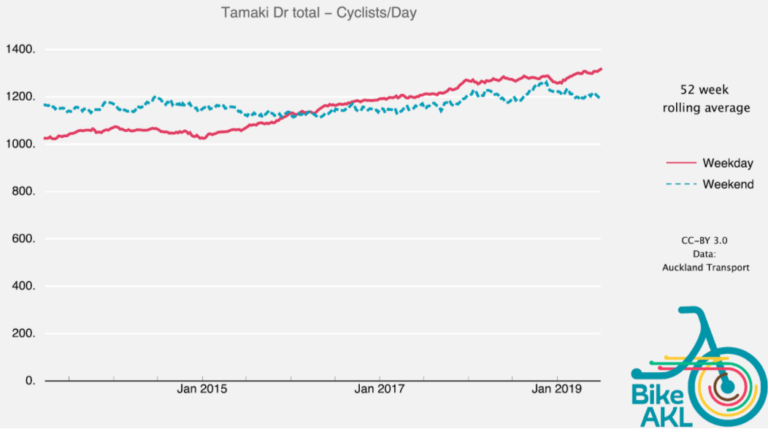
The resulting design is being expressly hailed by local politicians and some of the media as a smart compromise “saving 40 car parks”. It’s even the top of AT’s own bulleted list of features, in its consultation page on the new design. Talk about what you value…
Instead, what’s been sacrificed instead are AT’s own design standards, which is bewildering for an explicitly safety-oriented upgrade. That improved shared path? Here’s AT’s Transport Design Manual guidelines released earlier this year:
4.4 Shared paths
A shared path is not an approved type and may only be used where numbers of cyclists and pedestrians are low enough to avoid frequent conflict.
We know the guideline doesn’t state what counts as “low” pedestrian numbers. But it’s pretty clear that a town centre on a busy urban beach, with car parking opening directly onto the pavement, is definitely not a place where we can get away with retaining shared paths.
Waka Kotahi / NZTA agree with the design manual in their own latest guidance, which makes it clear that shared paths should be on the way out pretty much everywhere. How many of the four situations below does St Heliers fall into as an appropriate location for a shared path? Closer to none than to one, we’d say.

AT’s own guidelines also recommend an 80-centimetre minimum “door zone” width next to parked cars. As many of us know well, there’s no buffer for doors at all on the existing path, and you’ve got to make your own allowances for the danger as best you can.
So with the promised bump from 2.4m to 4m, we’re actually getting a bit less than a metre of safely usable extra space overall.
That’s not much to work with when a door’s coming at you, as pointed out by Carol Green in her cheeky – but oh so trenchant – photo edit of AT’s consultation material:
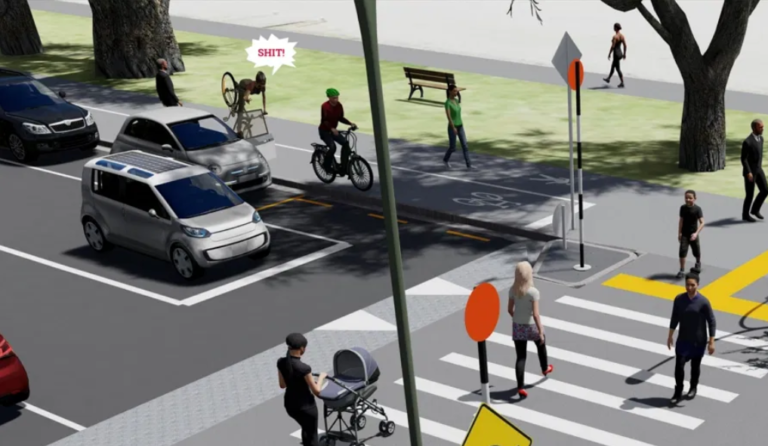
In a nutshell, and as seen elsewhere in Auckland, this shared path will not be a safe solution, unless you trundle along at walking pace. Existing and future riders on Tamaki Drive will either ignore it to keep riding on-road at a practical speeds for transport – with all the hazards that come from that – or they’ll ride the shared path slowly and grudgingly, while endangering and being endangered by other users.
So not only doesn’t this follow the design guidance, it also means that people on bikes will still have to share with pedestrians. Older or less mobile users, and families with children in particular, tend to have a bad time on shared paths with high bike use. And fair enough too. Having a bike pass you closely at 15~20 km/h (or more) doesn’t feel pleasant or safe.
But there are no safe or sensible choices for the person on that bike either – especially if they’re using a bike for time-sensitive transport rather than a leisurely ride. For that, a dedicated cycleway is needed, where you can safely move at regular bike speeds, not walking or running speed.
And make no mistake, people moving with purpose will be the future of Tamaki Drive’s cycle traffic, with the Glen Innes to Tamaki path due to unlock a wave of latent demand from East Auckland. In a few years’ time we’ll have plenty of people on bikes arriving at the end of Ngapipi Road alongside the Orakei Basin, coming or going between work, home and study – and they’ll either feel welcomed to St Heliers village, and its restaurants, shops and cafes… or scared away.
Shared paths come with a built-in glass ceiling. Runaway popularity is a problem: if lots of people ride them, the experience becomes worse and worse, for pedestrians, but also for riders (see ongoing coverage of the delayed fix for the NW bottleneck). And as word of mouth gets around and bike traffic levels out at ‘scarce’, the usual suspects pick it up as a stick to beat AT with.
When nothing’s better than something
We’re sounding downright frowny here. That’s not like us, is it? After all, the existing de facto shared path – one of the most popular in Auckland, over decades – will be getting an extra 1.6 metres of width. Isn’t that something we can get behind?
Unfortunately, if AT goes ahead with the current “better than nothing” proposals, then it’s very likely that “nothing better” will happen in St Heliers for at least ten years afterwards, potentially twenty years or more.
There’ll be severe resistance to digging everything up again in the medium term, which will partly come down to concerns over ratepayer value – and repeat disruption to businesses.
But barring some big changes, resistance to a future re-do will also be prompted by AT’s own protracted consultation, design and build processes and the uncertainty they create – especially if city-wide design standards are still up for local compromise. And that will mean the playing field remains tilted in favour of those who are able to dig in deepest against change.
That’s the opportunity cost of letting this one slide in 2020: locking in a safety improvement project that has had most of the safety consulted out of it, will be setting a(nother) precedent for short-changing tomorrow’s city to please the loudest objectors of today.
Listening to the community: who gets heard?
Is it realistic to expect AT to go against local community wishes? Well, that depends on what you define as “the local community” – and the way that AT has framed the conversation.
As we’ve come to expect from similar projects, there’s been serious opposition to car parking removal among many local retailers and surrounding residents. We understand that it’s really hard for AT to go up against aggressive, well-resourced and well-connected opposition. And bureaucracies are by nature very conservative, risk-averse entities.
But who’s not getting heard behind those loud, passionate voices of opposition, and who hasn’t even been given the opportunity to speak?
Looking at the process followed over the last year, it seems clear that AT hasn’t looked to find an acceptable compromise. No attempt seems to have been made in either consultation to to involve visitors and other users of Tamaki Drive – including people coming from all over Auckland who give the area so much of its energy and excitement, and who ought to be able to spend their time (and dollars) safely in St Heliers.
There’s also been no visible engagement with groups like Bike Auckland. And although they’ve come in handy for this blog, providing us with plans shortly before public consultation does not count as engaging us in the project’s development!
Having failed to get the public behind a safe system approach for all users of Tamaki Drive in the first public consultation, it’s disappointing to see no attempt to create a forum where people who supported a safer environment could be heard without being shouted down – even if that meant removing some car parking.
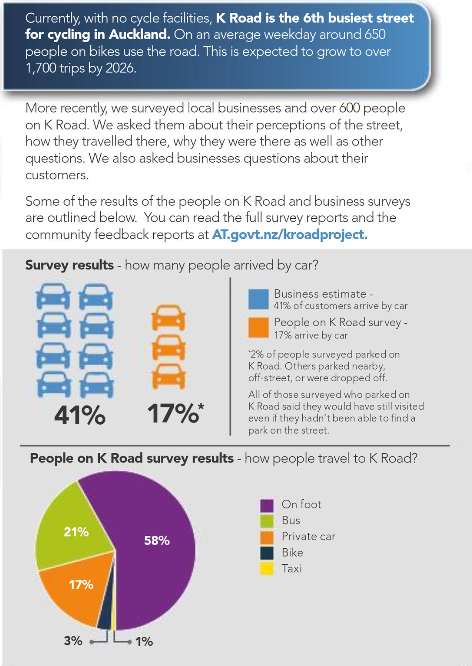
Amazingly, given it’s such a known hot-button issue in consultations, there has been no attempt to engage with retailers and challenge the idea of dependence on car parking, despite streetscapes with less parking working well for businesses in locations like Karangahape Road.
And while keeping parking is used as the reason safer options cannot be included in the current plans, there’s no evidence that AT has investigated whether excess car parking nearby could mitigate the ‘losses’ of parking on Tamaki Drive itself.
This project started as a response to crash statistics escalating, with the aim of providing a safe environment for all users. Somewhere along the way, that objective has been lost. And it’s concerning to hear from people within Auckland Transport that champions of active modes – those that are now supposed to be “embedded” across the whole organisation – are being sidelined.
If senior management in AT doesn’t promote a good faith process to achieve and sell a principled compromise – instead starting with “no car parks may be lost” and aiming straight for a compromised design – then it should come as no surprise that ever more AT staff that support walking and cycling are getting disillusioned and leaving.
A side effect of all of this is that the usual opponents of progress will feel vindicated, as they are the only ones who seem to be heard. This may in turn be taken as a sign by groups around the city who are keen to stop Council from progressing their policies. This is despite the fact that politicians who support these policies enjoy good public support at election time.
In short: AT have failed to adhere to their own design guidance, and have failed to undertake a good consultation or co-design process.
But it could be so simple…
See AT’s cross-section below? Just take the parked blue car away, and you have over 6m space on the sea-side. That’s easily wide enough for a proper generous footpath and a two-way cycleway, plus separator.
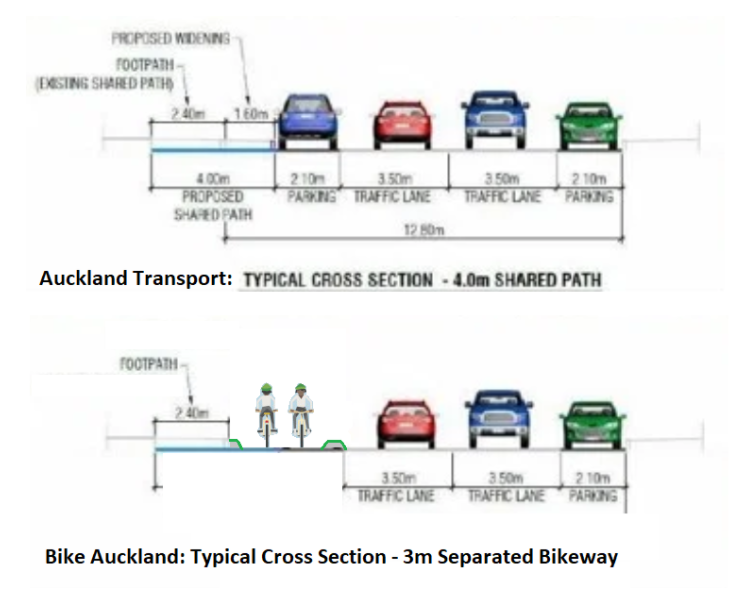 The existing footpath could stay as it is, and would be much nicer to walk on with the existing riders switched onto the cycleway. This design would also finally act on the promise of the Tamaki Drive Masterplan (see here and here), and deliver St Heliers a seaside promenade fit for the twenty-first century.
The existing footpath could stay as it is, and would be much nicer to walk on with the existing riders switched onto the cycleway. This design would also finally act on the promise of the Tamaki Drive Masterplan (see here and here), and deliver St Heliers a seaside promenade fit for the twenty-first century.
Speak up for the change we need
As we said earlier, if AT go ahead with the current proposals, they may be the only improvements in St Heliers for decades to come. The resistance to having another go will be severe. This is the real cost and risk of going ahead with this option.
We work hard to find the positive and advocate for improvements wherever we can find room for them. But here, we’re going to reluctantly play the long game – because we think it’s better for this project to be deferred totally in the name of a proper, safe outcome further down the track, even if this means changes in St Heliers are abandoned at this time.
Why add your voice to the feedback? Because we need to make it clear that the plans as they stand now are not widely supported.
If AT decides to proceed, it should do so knowing it’s in the face of significant criticism and opposition: ‘not in our name’.
And if there’s principled opposition to these flawed plans inside AT – embedded across the organisation, even – and concern among the ranks that the organisation is drifting away from its Vision Zero commitments and the cycling strategy, then we need to give those people the confidence to stand tall and speak up, for the benefit of St Heliers and the rest of our city.
A ray of light at the end of the tunnel…
AT will soon publicise similar plans for nearby Mission Bay, also consulted on in 2019. And unlike St Heliers, we understand the powers-that-be have decided there might just be enough space for adding a separated cycleway (coincidentally, without impacting parking). Mission Bay might well end up being the O’Connell Street shared space to St Heliers’ High Street, showing businesses and other opponents of separated cycleways just what they’re missing out on.
We’re optimistic, as always – but progress starts with a clear “do better” message for St Heliers, so let’s send that message now, loud and clear!
Ideas for your submission
Bike Auckland encourages those submitting on this project to tell AT that you either
- don’t support this project (and say why), or
- support with changes – with clear statements of what those changes should be (BUT note that if you tick this option, you will likely end up being counted as “in favour” at least in the headline results of AT’s consultation summary – even if they change nothing about the plans…)
We can’t support the project in its current form because it doesn’t include adequate safe provision for pedestrians or cyclists, and is inconsistent with AT’s Transport Design Manual and the Vision Zero commitment of AT and Auckland Council.
Be direct and forthright with AT about the issues you might see with the project as proposed, and what it would mean to you (as a person, with or without bike!) if AT gets it right in St Heliers.
Here’s what we think a quality design would look like:
- Create a dedicated, bi-directional protected cycle path, by removing parking on the northern (beach) side of Tamaki Drive.
- Strengthen the now very limited traffic calming proposals, to support the proposed 30 km/h speed limit.
- Add two key missing raised table pedestrian crossings: one across Tamaki Drive at Vale Road, and the other at the intersection of Tamaki Drive and The Parade.
- Discard plans for additional car parking on Goldie Street – at least, until we know the spaces on Tamaki Drive are definitely on the way out…
- Ensure a result that creates healthy space for all the ways we move now – walking, cycling, scooting, strolling, rolling – and accommodates people of all ages and abilities, in line with Auckland Transport’s mandates for Vision Zero, climate action, and mode shift.
Make the feedback clear, make it yours and make it count!

